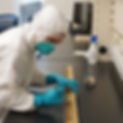Research
Aquatic Ecology & Paleolimnology

Great Lakes Research
Being situated on the shores of Lake Erie has served as a source of inspiration and inquiry. Our lab is currently engaged in projects aimed at understanding primary production and lower food web dynamics in near shore environments, recent histories of environmental change contained in lake sediment archives, and biogeochemical cycling and sedimentation rates along the terrestrial aquatic interface. Our interests are not limited to the Laurentian Great Lakes, we are also conducting research on the African Great Lakes and the Great Lakes of Iowa.
Featured research: COMPASS FME Project
Global Change Science & Macroecology
While the official golden spike of the Anthropocene is still being debated, there is no doubt that human driven environmental change has accelerated over the past several decades, which has resulted in major impacts to many ecosystems. Sedimentary records recovered from lakes are useful for uncovering abrupt community reorganization and changes in functional traits driven by environmental change. Further, paleolimnological archives have shown that there has been increases in the last occurrences of biota across North America concomitant with anthropogenic change . Our lab uses both open online data repositories and paleoecological records to test ecological theories (e.g., ecological resilience theory) to better understand the dynamics and drivers of rapid community reorganization and changes in ecosystem structure and function.
Featured research: PNAS Vegetation Paper



Algal Ecology & Evolution
Single celled eukaryotic algae are prolific in almost all bodies of water – from the smallest puddle to the vast expanse of the oceans. Diatoms are an especially abundant group of algae, and their silica cell wall allows for them to be preserved in sediments that collect in lake and ocean basins. My lab is interested in how algae function across the levels of biological organization - from populations to ecosystems. At the population level, we are interested in how diatoms are dispersed, their life history traits, and how they evolve; at the community level, we are interested in species coexistence, community assembly processes, and the functional diversity of algae; and, at the ecosystem level, we are interested in what diatoms can tell us about long-term ecosystem dynamics and landscape evolution.
Featured research: Ohio Sea Grant Funding
Ancient Environmental DNA
Our lab is interested in how lakes operate as archives of biological and chemical changes within their catchments. Further, we are interested in new theoretical and methodological approaches to the study of paleolimnology. For instance, our lab has an ISO 6 clean room facility to extract and purify ancient environmental DNA (aeDNA). This facility coupled with next-generation sequencing allows us to understand the evolutionary and ecological dynamics of microbial eukaryotes, interactions in the lower food web, and biodiversity changes over long timescales. Further, we use the application of aeDNA to reconstruct communities of organisms that leave no visually identifiable remains within sediments.
Featured research: TREE aeDNA Paper
